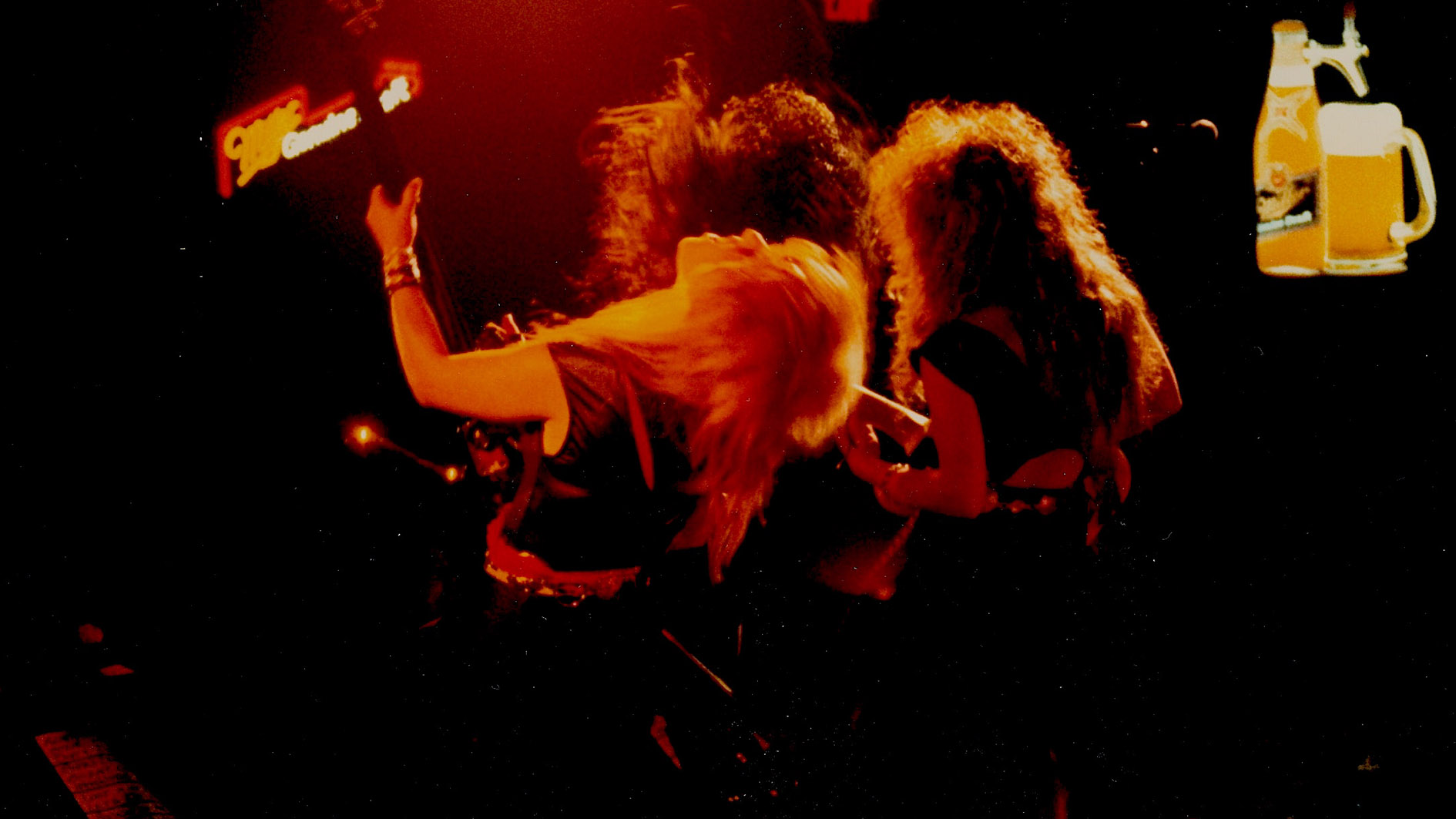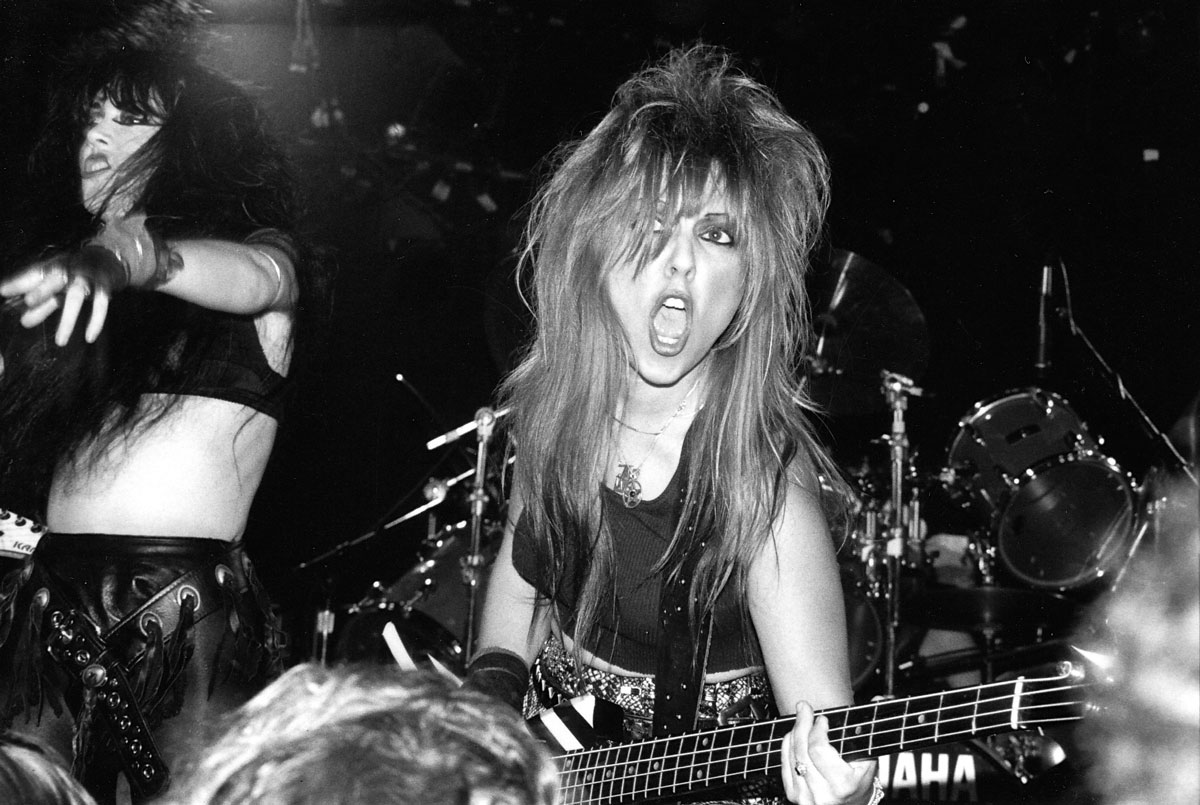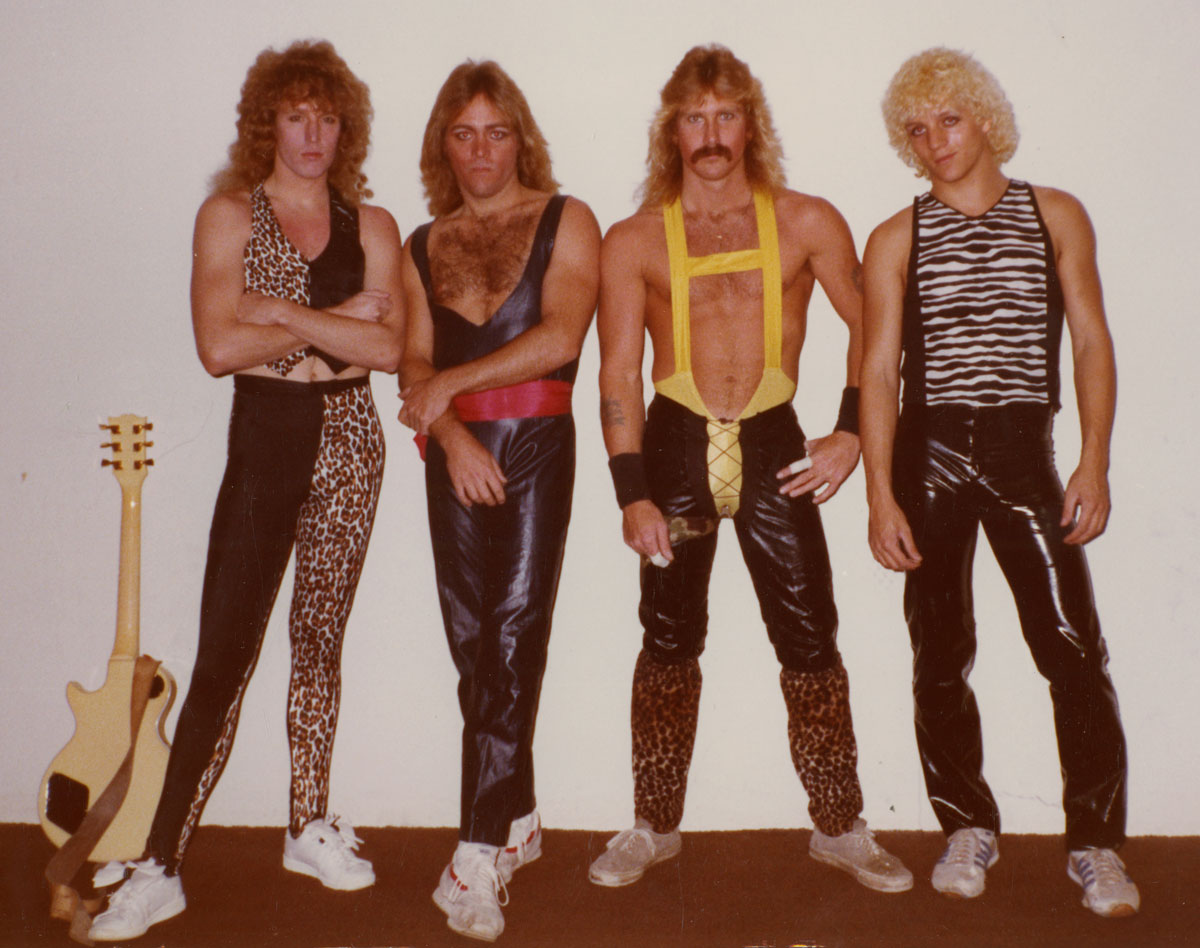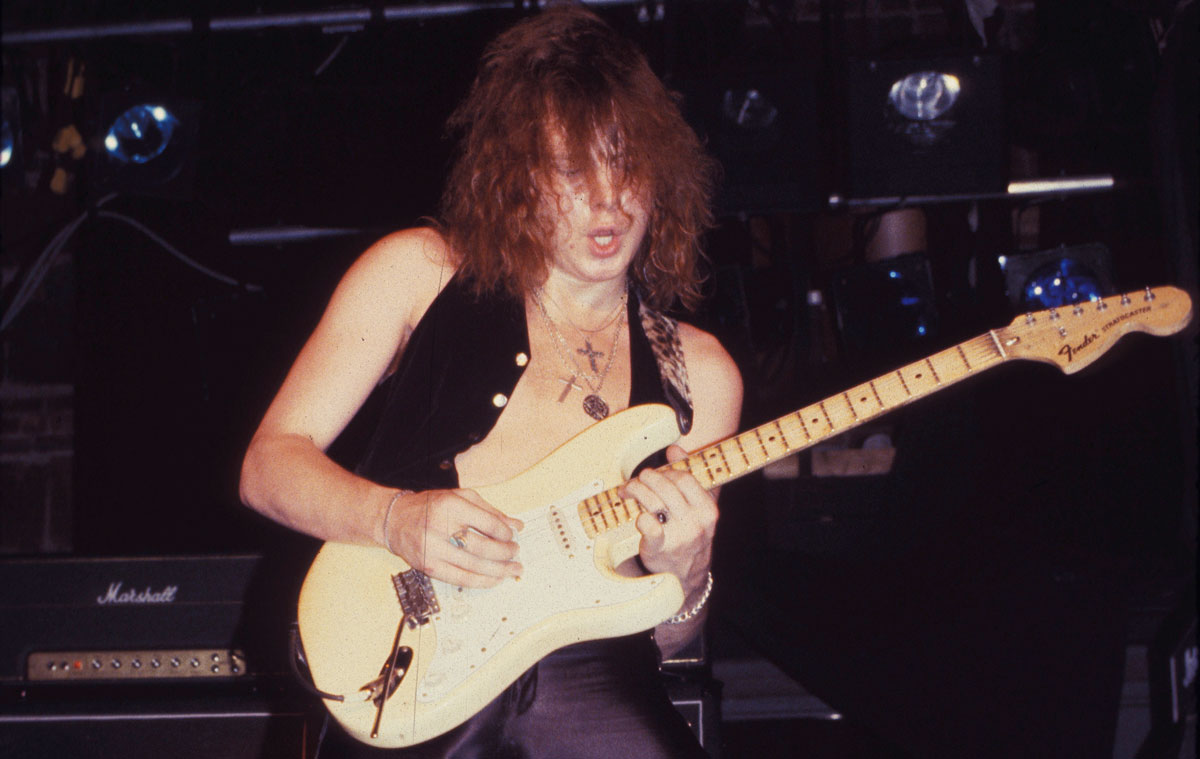Opening for Guns N’ Roses, taking lessons from Randy Rhoads and trading licks with Steve Vai: what the Sunset Strip's golden era was really like
As a new compilation album assembles some of the era's deepest cuts, Jaded Lady guitarist Danelle Kern and Romeo and Hellion alum Chet Thompson recall their fondest memories from the epicenter of shred guitar

Few could argue the impact and outright awesomeness of Sunset Strip-made metal and hard rock. From innovators like Eddie Van Halen and Randy Rhoads, to the sneering, Marlboro-dangling swagger of Slash, the Sunset scene of the ‘70s and ‘80s made for a a hotbed of guitar god activity that would spill out of the Strip and onto MTV.
The players likewise changed the way we look at guitar, continuing to inspire generations of finger acrobats the world over.
That’s only scratching the surface, though. Beyond those that broke into the mainstream, there were bands whose stars may not have burned as bright, but nevertheless injected plenty of blood, sweat, and hairspray into their local scene.
Enter Bound For Hell: On The Sunset Strip, a loving tribute to the talents that shared stages with the icons – even headlining prime venues like Gazzarri’s and the Whisky a Go Go – but got lost in the overwhelming shuffle of the Hollywood scene.
“Players [were] just booming out of Los Angeles,” recalls Chet Thompson, a former shredder for bands including Hellion and Romeo. It wasn’t uncommon for him to trade licks backstage with Steve Vai, Lizzy Borden’s Joe Holmes, or W.A.S.P.’s Chris Holmes. On-stage, he’d drop to his knees to rock through Romeo’s Feeling to Rock with a Karl Sandoval star guitar flipped upside down (that juiced-up track is preserved on Bound For Hell: On The Sunset Strip).
Bound For Hell has been percolating behind the scenes for the past few years, ever since cult archivists The Numero Group began uploading ‘80s-vintage demos from L.A.’s leathered-and-chained Jaded Lady to Spotify in 2018.
Guitarist Danelle Kern had first joined her bandmates in the early ‘80s as the rhythm guitarist of their earlier incarnation, Leather Angel (both acts are on the compilation).
Get The Pick Newsletter
All the latest guitar news, interviews, lessons, reviews, deals and more, direct to your inbox!
By ’86, she was surging through lightning-laced, hammer-on leadwork for thunderous Jaded Lady cuts like Rock ‘N Roll Ain’t Pretty. They were a force to be reckoned with at Sunset spots like the Troubadour or the Country Club.

“The clubs were really great. I especially loved the sound at the Whisky. It seemed like the stage was alive, there,” she says, adding of the era, “The vibe of the bands, the dress, and the music… it was just a whole package of coolness.”
In the model of Numero’s in-depth explorations of regional soul scenes and out-of-print emo, Bound for Hell is a 21-song highlight reel of the underexposed parts of the Sunset Sound.
Some recognizable names pop up, including Armored Saint, Lizzy Borden, and future Kiss guitarist Tommy Thayer’s Black ‘N Blue, but it also uncovers rare bangers from folks who worshipped at the altar of EVH (Stormer’s Going to the City; Reddi Kilowatt’s Liquid Lady), or reveled in ‘80s excess (L.A. Rocks’ Cocaine) – all primed to now be pumped out of a vintage T-bird in your local heavy metal parking lot.
Speaking with Guitar World, Kern and Thompson get into their respective starts on the Strip, iconic guitar teachers, and some likely staggering backstage riff exchanges now lost like tears in Aqua Net.
What are your memories of first hitting the Strip?
Danelle Kern: “Well, I had started in Orange County, so there was the Woodstock out there, and Jezebel’s. I was in a band with some guys called Drive, and I was playing all those places. But when the guy band didn’t seem to take off, I saw Leather Angel were looking for a second guitarist. I contacted them, and then my whole focus shifted to LA.
“Actually, me and the girls did do some gigs in Orange County, but the main [priority] was [the Sunset Strip]: the Troubadour, Gazzarri’s, and the Country Club.”
Chet Thompson: “I ended up on the Strip in a weird way. I was playing in local garage bands, but then I saw Randy Rhoads play. I signed up for lessons with him, and after six months Randy said I was his best student. [He told me,] ‘I’ve got a band for you to join; you’re going to kill it!’ That was Alice ‘N Thunderland. He introduced me and I joined that band.
“I think our first gig was at the Whisky or the Troubadour. I was there for two years, [but when] Randy died in a plane crash I quit guitar. I decided to ride motocross, [but] I got injured; I wasn’t very good at motocross. It was a bummer because I really liked it – I just wasn’t good. The only thing I was good at was guitar.
“[Drummer] Kevin Berry found me at a nightclub, and was looking for a guitar player for a band called Romeo; Kevin had been playing in a band with Randy Rhoads’ brother, Kelle. From there, [I played in] Romeo, then Hellion, WWIII, Slamnation, and a bunch of other bands.”
Kern: “Hey Chet, did I ever meet you in LA?”
Thompson: “Which bands were you in?”
Kern: “Jaded Lady, Leather Angel. You know what, I bet your band and my band played together, and we did an autograph session at Moby Disc Records.”
Thompson: “We did! Back when you actually had records, and when the store was still open, right?”
Were you signing records? Promo photos?
Kern: “I think it was for Ladykillers, do you remember Chet?”
Thompson: “Wow, yeah… so that was a compilation with some of the best bands in L.A. at that time. Hellion was on [the record], so it was an autograph session for that.”
Romeo didn’t have any trouble fitting in. We played and won the BAM Magazine battle of the bands, and after that we had no trouble getting gigs anywhere
Chet Thompson
What was the climate like for bands breaking into the scene? Was there much competition getting those slots?
Kern: “Well, the girls had Keith Dyson as a manager. He was getting groups into the Troubadour, the Whisky, Gazzarri’s – all the big clubs there. And we were headlining. I think it was just a matter of having the draw, and the fans. We didn’t have any problems getting into the clubs, basically…but then we fired him [laughs].”
Thompson: “Romeo didn’t have any trouble fitting in. We played and won the BAM Magazine battle of the bands, and after that we had no trouble getting gigs anywhere.
“I don’t if you knew her, Danelle, but one of my best buddies was Gina Zamparelli – I went to school with her; she’s [since] passed away. Gina was the promoter at Perkins Palace is Pasadena, and she’s literally responsible for breaking bands Armored Saint and Ratt.
“Chris Holmes from W.A.S.P. and I grew up together, and he used to hang out in her house all the time. [Gina was] the heaviest name in booking during the early ‘80s. There was a lot of pay to play – bands literally had to pay money to go onstage, or buy tickets and sell them to their friends – but she fought against that.”

Chet, you mentioned getting lessons from Randy, but Danelle, at one point you were studying under George Lynch, right?
Kern: “The singer and the drummer of the guy band I was in were really good friends of George, and that’s how I met him. It turned out George lived just around the corner from me, so I took a few lessons from him, but also a jazz guitarist, and anybody else that wanted to teach me something. I was open to it!
“One time we were rehearsing in Burbank and this guy just barged in, like ‘Let me show you this cool thing on guitar,’ like an Eddie hammer-on thing. I was like, ‘Sure!’ I loved that I could use that in a solo. Mick [Mars], George, and even Eddie Van Halen barged in on us; also, Ronnie James Dio. It was just a cool climate of rock stars, you know!”
Thompson: “Danelle’s exactly right, there were so many people around [that] it was hard not to pick up stuff. I studied with Randy for about a year, and then I played with his brother for a short time. I studied with Tommy Gervin, who played with Eddie Money up until Eddie passed.
It was a great time to learn and play, thanks to Eddie, George, Randy, or players like Warren DeMartini and Jake E. Lee from Ratt. Players were just booming out of Los Angeles
“Lizzy Borden played a lot of shows with [Hellion], and their guitar player Joe Holmes and I would just trade licks back and forth – Joe got the Ozzy gig for a short while [1995-2001].
“We all rehearsed at this place Mates – Kiss, Quiet Riot, Ozzy, and a bunch of bands like us [were] in there. Gene [Simmons] was always in our studio. In fact, we got to record with him and Ted Nugent at one of our sessions.
“WWIII went to Eddie’s house in Cold Water Canyon [ed. 5150 Studios], and we [also] got to record at Sunset Sound. Like Danelle was saying, it was a great time to learn and play, thanks to Eddie, George, Randy, or players like Warren DeMartini and Jake [E. Lee] from Ratt. Players [were] just booming out of Los Angeles.”
Kern: “I agree – fast, jammin’ guitar riffs. How about when Yngwie came on the scene... my gosh.”
Thompson: “Romeo opened up for Alcatrazz in San Diego at the Fox Theatre. I was excited to open up for Yngwie – I knew his licks, because I went to a violinist to learn all those classical arpeggios and sequences that Yngwie did.
“I learned how to do sweeping arpeggios on violin, and transferred that to guitar. I couldn’t wait for him to play Kree Nakoorie, but when we got to San Diego for the soundcheck, there was no Yngwie. But guess who replaced him? Steve Vai! So, I got to hang out with Steve Vai and trade licks. I ended up teaching Steve Vai’s brother-in-law for years.
Kern: “That’s not a bad tradeoff!”
Thompson: “Yeah, I forgot about that.”

Did you feel any pressure to compete with – or outperform – the other guitarists on the scene?
Thompson: “I didn’t have a competitive mindset; I just wanted to cut my own path.”
“I was classically trained. Randy asked me, ‘Why are you getting so good so fast’; it was because I was taking classical guitar classes [at the same time], [and] I gave classical guitar performances. I decide to create my own style; that’s why I did my two-handed tap solos with my guitar upside down. Everyone thought that was pretty cool!”
Getting into the music on this compilation, Danelle, Jaded Lady’s Rock N Roll Ain’t Pretty was on the band’s first demo from ‘86; you played it on public-access TV around the same time. As far as Bound For Hell goes, was this the band’s signature song?
Kern: “Yeah, we were on the Nu Rock TV Show. It was Rock N Roll Ain’t Pretty, and two other songs: Shoot Me With Your Love and Give It All You Got. It’s all on YouTube. I don’t know… Everybody seemed to like Rock N Roll Ain’t Pretty a lot. It went along with us being tough girls, you know?”
You’ve got a nice and wild, reverse bend/hammer-on section through your solo, there. Did you sculpt out leads, or was that all off-the-cuff?
Kern: “I would play all my solos the same in every song, so that if the fans were listening to the record, when the solo would come up live and they’d want to do some air guitar, you’re gonna know it! That’s how I viewed it.”
Chet, what can you tell me about Romeo’s contribution, Feeling to Rock?
Thompson: “We’ll, we wrote it in the garage. Mike [Britton, Romeo frontman] was a really good singer, but everybody in the band sung. So, we had four-part harmonies – we strived to do that with every song.
“I think I was 22 in Romeo, and I started guitar at 18. I’d only been playing for four years. Randy got his Bow Tie guitar built by Karl Sandoval, and he would [sometimes] borrow my Les Paul onstage, because I also had a cream Les Paul.
A lot of the producers and engineers responsible for that '80s sound, they tell you to slow down and put in a groove – and that happens in pre-production
Chet Thompson
“I asked him, ‘Where can I get a guitar built like this [the Bow Tie V]?’ I had Karl build me a star guitar, and I designed it like a Les Paul, to have a mahogany body and a flamed maple top to get that warmed tone, and the brightness from the maple. I only had one pickup put in it – that’s what everyone was doing because of Eddie Van Halen. That has a lot to do with the great tone: the mahogany body, the maple neck, and the one pickup, all fired into Marshalls.”
In the Bound for Hell liner notes, Chet, you mention that you felt Feeling to Rock was recorded a little too fast…
Thompson: “Part of the secret to all those ’80s bands [is] who produced it and who engineered it. Those are the unsung heroes, folks like Mikey Davis, Ron Nevison. You might have had a good guitar tone, but they dial it up, and they also tell you to slow the f down.
“Like, ‘Guys, you’re too excited [to be] in the studio!’ And then you lose the groove, right? A lot of the producers and engineers responsible for that ’80s sound, they tell you to slow down and put in a groove – and that happens in pre-production. We didn’t have that; we had a day to record. And we were pumped! So that’s how it came out: fun and fast. I guess it’s ok, because it made it on a record [1985's Rocks].”
Kern: “I agree with you, Chet. We did a song called On The Run for Ladykillers, and, man, that’s how it sounded – like it was on the run. It’s a little fast.”
Backing up slightly, what was your set-up through your Jaded Lady period, Danelle?
Kern: “A 100-watt Marshall stack... Is there anything else? You know, it’s funny, when I got into Leather Angel they had just hooked up with a guy named Bob Rissi, and he had Risson amps. Leather Angel had gone with Risson Amps – Mötley Crüe had gone to Risson, [too]. I didn’t play them for very long – probably not even a year – but I always had my 100 Watt Marshall stack. I also had BC Rich guitars.”
Quintessential ‘80s guitars! What were you holding?
Kern: The Bich! In fact, it was the second one made off the line. A lot of the name guys – Neil Giraldo, Aerosmith – were starting to play BC Rich. It was a really nice guitar. I still have my Rich Bich; that’s the one I’m playing on this compilation album. I still play it to this day.
I was a legal secretary in a dress during the day, and in leather and chains at night
Danelle Kern
“Neal Moser was there at BC Rich [at the time] – he went on to make his own guitar company. I have a Neal Moser guitar also; it’s shaped like an axe.”
Were there any under-sung players in the scene you felt should’ve gotten more attention? And are any of them on this compilation?
Kern: “I don’t really know how to answer that. I knew all the names of the bands, but I never really listened to them. I was trying to work a job, go to rehearsal, do the gigs; that kind of thing. I was a legal secretary in a dress during the day, and in leather and chains at night.”
Chet, are you on the Hellion song on this compilation, Up From the Depths?
Thompson: “No, I don’t think so. I was on Hellion’s [1987 debut LP] Screams in the Night album, [1990’s] The Black Book as a guest player, and some guest guitar solos on [vocalist Ann Boleyn’s] latest work.”
What was your most memorable show with Jaded Lady, Romeo, or otherwise?
Kern: “We opened up for Guns ‘N Roses, and we opened up for Motley Crüe. Having the places packed was awesome; I always found that the more people were there, the better I played. We also played the LA Street Scene festival – a sea of people, as far as the eye could see. We were sitting in a pizza joint [after the set] and they showed us on the news. That was pretty darn memorable.”
Thompson: “It was with Hellion in the USSR, 1990. We played at the Moscow Olympiad sports arena for Monsters of Rock. That was a huge arena, tens of thousands of people.
“At that time, the kids were starved for heavy metal. We brought Marlboro cigarettes, Lakers t-shirts, and Levi’s jeans; we were told we could give those to people. That was awesome, to go onstage and hear the pounding of the stage as we were walking up. Cannons were going off. That was cool.”
What does it mean to either of you to have this compilation come out, potentially introducing your music to a new generation of metalheads?
Kern: “I think I want to go back and play! I mean, I think it’s awesome. You can spark a whole new generation of fans that way.”
Thompson: “I’d have to go find my spandex pants and see if I can still fit in them.”
Kern: “All my spikes, leathers, and chains…”
Thompson: “[Those spandex pants] are probably just standing up in a closet; all of the sweat just turned them into a creature of their own.”
- Bound For Hell: On The Sunset Strip is out now via The Numero Group.
Gregory Adams is a Vancouver-based arts reporter. From metal legends to emerging pop icons to the best of the basement circuit, he’s interviewed musicians across countless genres for nearly two decades, most recently with Guitar World, Bass Player, Revolver, and more – as well as through his independent newsletter, Gut Feeling. This all still blows his mind. He’s a guitar player, generally bouncing hardcore riffs off his ’52 Tele reissue and a dinged-up SG.
“Every tour was the best I could have done. It was only after that I would listen to more Grateful Dead and realize I hadn’t come close”: John Mayer and Bob Weir reflect on 10 years of Dead & Company – and why the Sphere forced them to reassess everything
“Last time we were here, in ’89, we played with Slash on this stage. I don't remember what we did...” Slash makes surprise appearance at former Hanoi Rocks singer Michael Monroe's show at the Whisky a Go Go


![John Mayer and Bob Weir [left] of Dead & Company photographed against a grey background. Mayer wears a blue overshirt and has his signature Silver Sky on his shoulder. Weir wears grey and a bolo tie.](https://cdn.mos.cms.futurecdn.net/C6niSAybzVCHoYcpJ8ZZgE.jpg)

![A black-and-white action shot of Sergeant Thunderhoof perform live: [from left] Mark Sayer, Dan Flitcroft, Jim Camp and Josh Gallop](https://cdn.mos.cms.futurecdn.net/am3UhJbsxAE239XRRZ8zC8.jpg)






